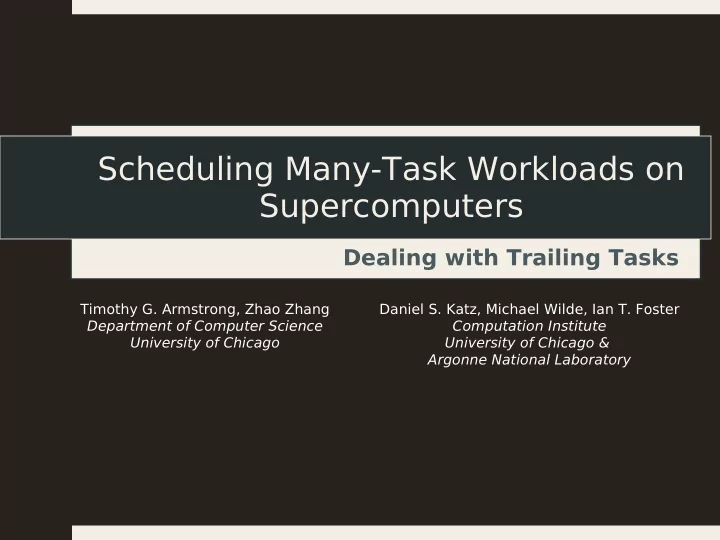

Scheduling Many-Task Workloads on Supercomputers Dealing with Trailing Tasks Timothy G. Armstrong, Zhao Zhang Daniel S. Katz, Michael Wilde, Ian T. Foster Department of Computer Science Computation Institute University of Chicago University of Chicago & Argonne National Laboratory
Many-tasks on a Supercomputer Multi-level scheduling Metrics: time to solution and utilization Inputs ...... ...... Tasks ...... Outputs ......
“Trailing T ask” Problem Utilization using 160,000 cores with molecular docking workload of 935,000 independent tasks. Last task completes at 7828 seconds
Runtime Distributions T ask runtimes can follow various distributions Often highly skewed: maybe power law or heavy-tailed distribution Nearly symmetrical distribution of Many-task computing runtimes (another DOCK workload) systems should gracefully handle long-running tasks Runtimes with same mean as above but log-normal distribution
Obstacles to Shedding Workers Can't always just return unneeded worker CPUs to a pool Reasons: Scheduler support Policy restrictions Scheduler not designed for tracking many small allocations Schedule fragmentation Network topology; spatial fragmentation of machine Resource provisioning granularity: thousands T ask scheduling granularity: one
“Bag of T asks” Workloads We only consider workloads with no dependencies: number of “ready” tasks decreases monotonically Most many-task application like this when winding down Similar to a stage of an many-task application with parallel barrier after stage. E.g. MapReduce pattern Inputs ...... ...... Tasks Outputs ......
Fixed Worker Count Minimizing time to sol. leads to maximizing utilization NP-Complete optimization problem with heuristics*: Arbitrarily assigning tasks to idle workers (random) : 2x opt. Assigning longest running tasks first (sorted) : 4/3x opt. Average case behavior for both is better Wastage Workers Allocation Duration *Many more in scheduling literature
Living with Unknown Runtimes In an ideal world we would know the runtime of each task. In practice it is unrealistic assumption Random scheduling is what we must live with typically
Trade-off with Fixed Worker Count With random, unavoidable trade-off between utilization and time to solution
Chopping off the T ail of T asks When utilization gets too low, switch to a smaller allocation No special scheduler/system support required Chopping off the tail No tail-chopping
T ail Chopping: Worthwhile? T ail-chopping promises to provide: A better trade-off between TTS and Utilization High utilization more robust to changes in worker count But has costs: Overhead of migrating to new partition Loss of task progress (unless tasks can be checkpointed) Slower progress on smaller partition Delays in requesting allocation Assumptions for study: T ail-chopping means progress of incomplete tasks lost Fixed delay in acquiring new partition
Simulation Design T ask/worker ratio decides how many workers to request Threshold % of idle workers triggers tail-chopping Sweep over parameter values to find trade-off curves for different idle thresholds
Simulation Data Runtimes of 935,000 molecular docking tasks Skewed distribution of runtimes Available allocation sizes those on Blue Gene/P Intrepid
Simulation Results (1) - Sorted Sorted scheduling Effect on time to solution Effect on trade-off Effect on utilization
Simulation Results (2) - Random Random scheduling Effect on time to solution Effect on trade-off Effect on wastage
Experiment on Blue Gene/P Proof of concept on Blue Gene/P Intrepid at Argonne National Laboratory using Falkon task dispatcher Provisions machine partitions using task/worker ratio. Chops off tail when idle workers above 50% threshold
Possible Improvements “Warm up” partition before canceling old one Scheduler support for shedding workers T ask migration Better heuristic for when to chop tail: use available information about task runtimes
Conclusions Need to consider scheduling when running many-task application on a supercomputer, especially if runtimes of tasks are highly variable Favorable utilization/time to solution trade-off not always possible with fixed worker count T ail-chopping can give better results for time to solution and utilization T ail-chopping delivers robustly high utilization
Questions?
The “Straggler” Problem Described in MapReduce literature; related but different “Straggler”: a task that is running slowly due to poor hardware/software performance Standard solution: replicate the task on other machines Only works if the long-running tasks don't intrinsically involve more computation
Recommend
More recommend